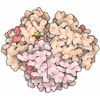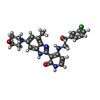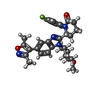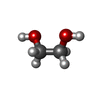Entry Database : PDB / ID : 8fupTitle Bromodomain of CBP liganded with BMS-536924 and CCS-1477 CREB-binding protein Keywords / / / / Function / homology Function Domain/homology Component
/ / / / / / / / / / / / / / / / / / / / / / / / / / / / / / / / / / / / / / / / / / / / / / / / / / / / / / / / / / / / / / / / / / / / / / / / / / / / / / / / / / / / / / / / / / / / / / / / / / / / / / / / / / / / / / / / / / / / / / / / / / / / / / / / / / / / / / / / / / / / / / / / / / / / / / / / / Biological species Homo sapiens (human)Method / / / Resolution : 1.7 Å Authors Schonbrunn, E. / Bikowitz, M. Funding support 1items Organization Grant number Country Not funded
Journal : To Be Published Title : Structural basis of CBP and EP300 interaction with kinase inhibitorsAuthors : Schonbrunn, E. / Bikowitz, M. History Deposition Jan 18, 2023 Deposition site / Processing site Revision 1.0 Feb 7, 2024 Provider / Type
 Open data
Open data Basic information
Basic information Components
Components Keywords
Keywords Function and homology information
Function and homology information Homo sapiens (human)
Homo sapiens (human) X-RAY DIFFRACTION /
X-RAY DIFFRACTION /  SYNCHROTRON /
SYNCHROTRON /  MOLECULAR REPLACEMENT / Resolution: 1.7 Å
MOLECULAR REPLACEMENT / Resolution: 1.7 Å  Authors
Authors Citation
Citation Journal: To Be Published
Journal: To Be Published Structure visualization
Structure visualization Molmil
Molmil Jmol/JSmol
Jmol/JSmol Downloads & links
Downloads & links Download
Download 8fup.cif.gz
8fup.cif.gz PDBx/mmCIF format
PDBx/mmCIF format pdb8fup.ent.gz
pdb8fup.ent.gz PDB format
PDB format 8fup.json.gz
8fup.json.gz PDBx/mmJSON format
PDBx/mmJSON format Other downloads
Other downloads 8fup_validation.pdf.gz
8fup_validation.pdf.gz wwPDB validaton report
wwPDB validaton report 8fup_full_validation.pdf.gz
8fup_full_validation.pdf.gz 8fup_validation.xml.gz
8fup_validation.xml.gz 8fup_validation.cif.gz
8fup_validation.cif.gz https://data.pdbj.org/pub/pdb/validation_reports/fu/8fup
https://data.pdbj.org/pub/pdb/validation_reports/fu/8fup ftp://data.pdbj.org/pub/pdb/validation_reports/fu/8fup
ftp://data.pdbj.org/pub/pdb/validation_reports/fu/8fup
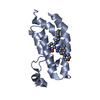



 F&H Search
F&H Search Links
Links Assembly
Assembly

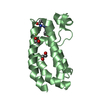
 Components
Components Homo sapiens (human) / Gene: CREBBP, CBP / Plasmid: pNIC28-Bsa4 / Production host:
Homo sapiens (human) / Gene: CREBBP, CBP / Plasmid: pNIC28-Bsa4 / Production host: 
 X-RAY DIFFRACTION / Number of used crystals: 1
X-RAY DIFFRACTION / Number of used crystals: 1  Sample preparation
Sample preparation SYNCHROTRON / Site:
SYNCHROTRON / Site:  APS
APS  / Beamline: 23-ID-D / Wavelength: 1.03319 Å
/ Beamline: 23-ID-D / Wavelength: 1.03319 Å Processing
Processing MOLECULAR REPLACEMENT / Resolution: 1.7→48.11 Å / SU ML: 0.22 / Cross valid method: THROUGHOUT / σ(F): 1.37 / Phase error: 20.52 / Stereochemistry target values: ML
MOLECULAR REPLACEMENT / Resolution: 1.7→48.11 Å / SU ML: 0.22 / Cross valid method: THROUGHOUT / σ(F): 1.37 / Phase error: 20.52 / Stereochemistry target values: ML Movie
Movie Controller
Controller



 PDBj
PDBj








